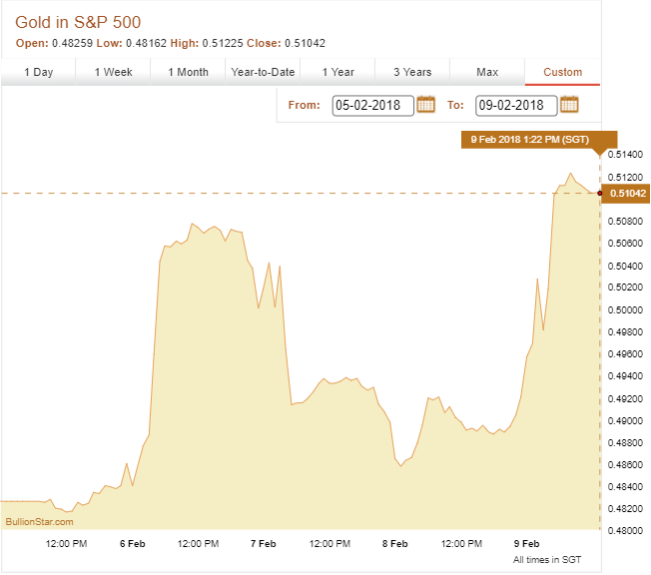The Role of Gold as Turmoil Hits Financial Markets
As market turmoil hits both equities and cryptocurrencies, the heightened volatility in these assets underscores gold’s unique role as a safe haven, store of value and portfolio diversifier.
Stock Market Selloffs
With major US stock indices falling again sharply on Thursday (DJIA – 4.02%, NASDAQ – 4.08%, S&P -3.41%), last Monday’s equity market selloff and spike in volatility looks set to be a more prolonged affair than a one-off plunge and recovery. The Dow’s Thursday close of 23860 is 2756 points, or 10.3% lower, than the all time high of 26616 from 26 January, and the Dow is now officially in correction territory. This week also saw two records added to the history of stock market selloffs, Monday’s biggest ever points drop in the Dow, and Thursday’s second biggest ever Dow points drop.
Similarly the S&P 500 index closed on Thursday at 2581 and is now 292 points, or 10.1% lower than its all-time high of 2,872.87 from 26 January, again in correction territory.
The NASDAQ composite, which also reached its all-time high of 7505 on 26 January, is virtually in a 10% correction zone below 6755, as it closed just a few points over this level at 6777 on Thursday.
Finally, the CBOE Volatility Index (VIX), the widely used measure of stock market volatility – which is also known as the investor fear gauge – had spiked up massively late Monday and into Tuesday to the 35-40 range, and critically was again seen approaching those levels at Wall Street market close Thursday.
Equity market indexes across the globe, as normal taking their cue from Wall Street trading, have also been falling in tandem, with markets in Europe, Asia and the Americas all lower on the week.
Whatever the reasons for the shift change in market sentiment, from macro factors to algorithmic trading, these abrupt index plunges and the rise in volatility have spooked investors across the globe and have led to panic selling and active profit-taking. With a low volatility environment less certain than before, market consensus on ever-increasing stock prices may be beginning to unravel.
Clouds over Cryptocurrencies
In cryptocurrency markets, the price euphoria seen in December and early January led by Bitcoin and some other large alt coin rivals has also given way to deep corrections and unclear price direction.
Until earlier this week when Bitcoin rallied back to above $8000 from below $6000, Bitcoin’s price had been on a consistent downward trajectory for nearly a month. From its intermediate high of US $17,000 on 7 January, in less than 30 days, the price had collapsed to below US $ 6,000, an approximate 65% drop. From the ultimate high of just over $20,000 on 17 December to the recent low of below $6000, Bitcoin’s price collapse exceeded 70%. Similar price movements were seen across the board in other crypto coin prices, both large and small cap.
Coupled with Bitcoin’s equally sharp price gains in late 2017, the short-term price movements of Bitcoin, both up and down, are hugely volatile. As recently as a year ago in early February 2017, Bitcoin in US dollars was still trading in the $1000 range. It was only in May 2017 when the price first breached the $2000 mark and August when it initially hit the $3000 range. As its meteoric rise continued, by late October the price had again doubled to $6000, and it was just mid-November 2017 (less than 3 months ago) when the Bitcoin price first traded in the $8000 range, a similar price range to where it now finds itself back at now.
Mid-November is also arguably the point at which Bitcoin’s dizzying ascent really got going, shooting up to over $11,000 before the end of November. It was at this point that hundreds of smaller alt coin prices started to really explode upwards also, taking the broad cryptocurrency market and the overall sector MarketCap much higher. Within a week between 1 December and 8 December, the Bitcoin price had again exploded to over $18,000, and the ultimate peak of $20,000 was reached less than 10 days later on 17 December.
After this, a series of lower highs and lower lows saw the Bitcoin price oscillate wildly in the $12,000 – $18,000 range before its prolonged fall from 7 January onwards to below $6000 on Tuesday 6 February, and its subsequent bounce to $8000. This high price volatility must raise the question of Bitcoin as store of value, and to what extent it is primarily a payment system versus a dependable store of value.
Gold’s Attraction in Market Turmoil
Investors in financial and other asset markets prefer predictability and stability. Hence investor apprehension at the growing uncertainty and heightened volatility in global stock markets and the recent pump and dump chart patterns of many cryptocurrencies.
But it is during market turmoil that gold’s safe haven qualities come to the fore. Since gold has no counterparty or default risk it is a universally known and universally used safe haven for preserving wealth during market crises. Gold’s high liquidity also adds to its safe haven appeal. During financial market turmoil, gold’s price therefore generally reflects this movement out of risk assets and into the safe harbour that gold provides. The below chart plots a relatively comparison between the US dollar price of gold and the S&P 500 index, over the week beginning Monday 5 February, showing gold’s outperformance as the US stock market suffered a series of selloffs.

Gold is also one of the traditional and best-known stores of value, some others being land and property. A reliable store of value asset will allow you to park your wealth and retrieve it at a later time knowing that it will still have value and will have retained the value that it had when you converted some of your savings or wealth into that asset. A reliable store of value will also adjust for inflation and retain its purchasing power relative to inflation. Physical gold in the form of gold bars and gold coins does just that and retains its purchasing power over long periods of time precisely because the gold price, as an inflation barometer, adjusts to reflect expected inflation.
Finally, gold can also reduce the volatility of a portfolio of investment assets such as stocks and bonds. By adding an investment in gold, the resultant portfolio displays less volatility of returns, and can also exhibit higher expected returns. This is due to the gold price having a low to negative correlation with the prices of securities such as stocks and bonds.
Popular Blog Posts by BullionStar
 How Much Gold is in the FIFA World Cup Trophy?
How Much Gold is in the FIFA World Cup Trophy?
 Essentials of China's Gold Market
Essentials of China's Gold Market
 Singapore Rated the World’s Safest & Most Secure Nation
Singapore Rated the World’s Safest & Most Secure Nation
 Infographic: Gold Exchange-Traded Fund (ETF) Mechanics
Infographic: Gold Exchange-Traded Fund (ETF) Mechanics
 BullionStar Financials FY 2020 – Year in Review
BullionStar Financials FY 2020 – Year in Review
 Gold, Geopolitics, and the Global Financial Realignment: Insights from Dr. Nomi Prins
Gold, Geopolitics, and the Global Financial Realignment: Insights from Dr. Nomi Prins
 Silver’s Breakout and What It Signals for Gold: Florian Grummes on the Metals Market Shift
Silver’s Breakout and What It Signals for Gold: Florian Grummes on the Metals Market Shift
 The Big Long: Gold’s New Chapter – A Conversation with Ronald-Peter Stöferle
The Big Long: Gold’s New Chapter – A Conversation with Ronald-Peter Stöferle
 How to Tell If Gold Is Real – What You Need to Know About Fake Gold, Testing Methods, and Trusted Dealers — A 2025 Guide
How to Tell If Gold Is Real – What You Need to Know About Fake Gold, Testing Methods, and Trusted Dealers — A 2025 Guide
 Is It Too Late to Buy Gold in 2025? 7 Signs Pointing to Gold’s Next Major Rally
Is It Too Late to Buy Gold in 2025? 7 Signs Pointing to Gold’s Next Major Rally






 BullionStar
BullionStar 1 Comments
1 Comments










